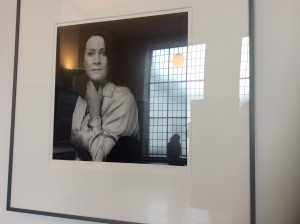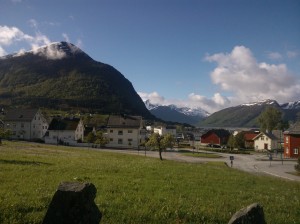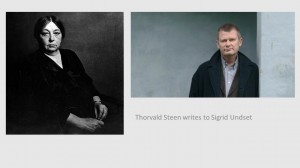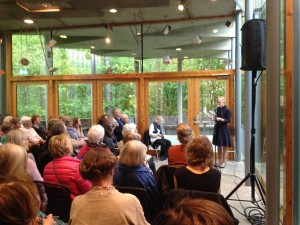Louisa May Alcott is one of the many women writing in the long nineteenth century. She has a wide array of novels and short stories and is most popular for her series on the March family; you may have read Little Women. Still today many of her works can be found re-published and translated. And as the Women Writers database illustrates she was a well-read author in her time[i]. Then why is she, like many other women writers of the nineteenth century, not included at length in literary histories[ii] or in educational curriculum nowadays? I remember reading multiple male writers from that period during high school (Charles Dickens, Henry Thoreau, Herman Melville, Frederik van Eeden, Piet Paaltjes and Multatuli to name a few I was privileged enough to read) however no female writers
Blog
Travelling TexTs at the first Nordic Digital Humanities Conference, by Viola Parente-Čapková
It is always a pleasure to meet and collaborate with colleagues who belong to the history of Travelling TexTs, i. e. to the networks formed thanks to the NEWW network and to the COST Action Women Writers in History, from which the TTT team has originated. This time, such a meeting was possible thanks to the fact that Anne Birgitte Rønning from the University of Oslo, a member of the COBWWWEB project, and Jenny Bergenmar from the University of Gothenburg, involved in the Swedish Women Writers on Export Project (http://lir.gu.se/english/research/swedish-women-writers-on-export), acted both as members of the Local Organizing Committee of the first conference on Digital Humanities in the Nordic Countries on March 15 – March 17 2016 (http://dig-hum-nord.eu/?page_id=352&lang=en). The purpose of the conference was to strengthen research, education and communication in the field of Digital Humanities, and make Nordic Digital Humanities more visible internationally – and, indeed, the organizers (Digital Humanities in the Nordic Countries, Oslo Digital Humanities Research Network, Norwegian National Library and Digital Humanities Center at Gothenburg University) fully achieved this goal and rendered the event truly memorable.
The conference attracted many participants, mostly, though not only, Continue reading
There is much more to find out, by Anne Elisabeth Kaldhol
Today, few common readers remember Dorothe Engelbretsdotter, Regine Normann or Marta Steinsvik. I was among those readers, until last spring.
My name is Anne Elisabeth Kaldhol and I study Librarian and Information sciences in Oslo. In spring 2015, I was a student intern at Volda University College, a small Norwegian country town by a fjord. Ferries and tunnels connect us to the rest of the country. It is a beautiful place with tall mountaintops covered in snow, which glitters in sunshine or more frequently in rain. Volda University College is situated right in the middle of it. The school has around 4000 students and 350 employees.
How does Dorothe, Regine and Marta fit into the picture? They are Continue reading
An intertextual coincidence at the Knowledge Exchange Workshop in The Hague, by Judith Rideout
The two-day knowledge exchange workshop Women’s History: Research, Dissemination and the role of the Digital (Huygens Institute, 29-30 September, 2015) featured many speakers who talked about travelling texts, but ironically it was during one of the first talks, about library digital initiatives, that evidence of a travelling text was discovered. Arno Kuipers, of the KB National Library of the Netherlands, was describing how the institution was working towards “Linked Data” and “Named entities”: names printed in digitized full text, already recognised by OCR software, can be linked to the authority file about persons in the library’s catalogue, or to international authority files. This would give the researcher an instant way to find out reliable information about a name s/he chanced upon in a text, and these metadata links would also cross-reference other instances of the author’s name appearing in the remaining corpus. Such a facility would be priceless to a researcher tasked with trying to find evidence of an author’s reception in what now amount to over ten million digitised pages of the library. Continue reading
I do not apologize for being born (Meet your mothers, 4/4), by Marie Nedregotten Sørbø
The third modern author, Thorvald Steen, gives much more information about his assigned foremother, Sigrid Undset, than Høvring did, throwing in facts and dates that anchor his letter to her life. He imagines visiting Undset in the hospital where she died in 1949, a time-traveller come back to report from the future on matters that may interest her, not least the fate of her own authorship.
Thorvald Steen writes more about Undset’s ethical and political significance Continue reading
A Patchwork of Women (Meet your Mothers 3/4), by Marie Nedregotten Sørbø
The second pair of authors was Mona Høvring (modern) and Camilla Collett (foremother). Høvring’s letter starts with a similar reluctance to write as Kjersti Skomsvold expressed; afraid that winter depression will make it a ‘’pitiful letter from the dead to the dead’. Through several instalments over the spring months, confronting ‘the overwhelming painfulness’ of life, she concludes with the rather ironic greeting ‘Lev vel’ (farewell, literally live well), making both the living and the dead author equally alive.
Mona Høvring embeds her address to Camilla Collett in female authors, actresses, Continue reading
A belated love-letter (Meet your Mothers 2/4), by Marie Nedregotten Sørbø
Kjersti Skomsvold writes what she calls a ‘belated love-letter’ to Amalie Skram, belated because she fell in love with her writing when working on her first novel (The faster I walk the smaller I am) published in 2009. She has since published three more books. Monsterhuman from 2012 is also now being translated into English (and other languages). Skram is like a huge pine tree in the woods, she finds, unruffled by storms, while Skomsvold herself felt like a scraggly bush, finding support in Skram’s language while attempting to complete her own book.
Skomsvold several times repeats Continue reading
Connecting with modern authors and audiences: Meet you mother in Norway (1/4), by Marie Nedregotten Sørbø
Our research team is not only mediating between two periods, the nineteenth century and today, but between groups of people that may often have very different approaches to literature. From the start of the HERA TTT project, we have focused on the idea of ‘meeting your mother’: to let modern readers and authors be introduced to, or reminded of, the women writers of the past, and relate to them in a personal way. For The Norwegian Literary Festival on May 28th this year, we deliberately asked professional authors – novelists and poets – to respond to the old authors, because we wanted the creative response as well as our own academic observations. One of the three authors (Skomsvold), indirectly points to the gap that often exists between the two worlds. She recounts how she felt daunted by the task of writing a letter to Amalie Skram, imagining professors of literature and literary critics watching over her shoulder, with their extensive knowledge (or so she assumes), blocking her ability to write freely, until she started thinking what she really wanted to say to Skram.
Our programme at Lillehammer, therefore, was composed Continue reading
Anna de Savornin Lohman and Amy de Leeuw- Perceptions of Selma Lagerlöf, by Kim Smeenk
Dutch women writers can’t be understood separately from their international context – and the same goes for other European, late 19th-century women writers. Take Selma Lagerlöf, for example, the famous Swedish writer of (among others) The Wonderful Adventures of Nils: we can’t ignore her in the timeframe around 1900. Her work could be found in many Dutch libraries, and many of her Dutch colleagues admired her.
Anna de Savornin Lohman, a very productive Dutch novelist, journalist and polemist, writes Continue reading
Een hardnekkig volkslied, by Janouk de Groot
In this series of blog posts (some in English and some in Dutch) we examine a number of interesting Dutch women writers featured in the forthcoming exhibition, “Because I had something to say” (“Omdat ik iets te zeggen had“), starting in the Museum of Dutch Literature on the 30th September, and continuing until the 15th November 2015. The exhibition is accompanied by a workshop, “Women’s History, Research, Dissemination and the role of the Digital”, at the KB National Library of the Netherlands, 29th-30th September 2015.
Wat als Twitter, Instagram en Facebook honderd jaar geleden al hadden bestaan? Die vraag schoot door mijn hoofd terwijl ik materiaal bekeek voor de tentoonstelling “Omdat ik iets te zeggen had”. Ik stuitte daarbij al snel op een opvallend citaat van Catharina van Rees (1831-1915)[i], die tegen Elise van Calcar verzuchtte: Continue reading






